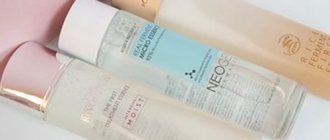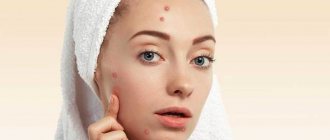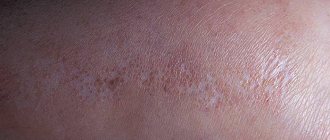Are you sure that you know how to properly care for combination skin, and are you sure that you have correctly identified this type? Caring for combination or problem skin is very different from the same daily care for oily and dry skin. It is necessary to combine drying of the nose, forehead and chin on “one” face and at the same time moisturize and tighten the cheeks and neck. I will share my PERSONAL experience on how to care for combination skin, prepare homemade lotion, tightening mask and choose a cream. I hope my advice is useful to you.
Basic winter skin care tips
People with different types of epidermis begin to experience difficulties and problems. During winter, it is necessary to change your skin care program. Despite the different types, there are general recommendations that will help maintain youth and beauty.
It is important to follow the following winter care rules:
- Beauty and health of the skin always come from within, so first of all you need to take vitamins, especially A, E, D.
- It is advisable to use a foundation. In winter, cosmetics serve not only for decorative purposes, but also for medicinal purposes.
- It is better to choose cream-based makeup products.
- If stars form on the skin, the cream should contain vitamin K.
- It is important to drink a lot of plain water. It will help saturate the skin with moisture from the inside and normalize sebum secretions.
- When taking a shower or bath, do not use too hot water. This leads to overdrying.
- Creams for facial skin care should be selected with vitamins C, E and D.
- The main damage is caused not by bad weather, but by dry indoor conditions. Therefore, it is good to purchase an air humidifier.
- After a bath or shower, the skin should be gently blotted with a towel rather than rubbed.
- In winter, you should give preference to nourishing and fortified masks. They need to be used several times a week a couple of hours before bedtime.
- It is important to use SPF protection of at least 30. Moreover, the product must have a filter from the best UVA/UVB.
Also, in winter you should not neglect visiting a beauty salon. It is best to do atraumatic facial cleansing, superficial peeling, nourishing masks and spa treatments, and facial massage at this time. It is also preferable to do rejuvenation in winter, since there is no risk of getting burns and age spots.
We recommend reading about nourishing face cream. You will learn how to choose a nourishing cream depending on the needs of the skin, and how to prepare the product at home. And here is more information about masks for dry skin.
Intensive nutrition and hydration
Dry facial skin needs good protection from external influences. The main companions for owners of this skin type are irritation, tightness and flaking. However, regular and ideally selected care will help avoid this. When choosing products, you should give preference to rich textures based on vegetable oils. Care for dry skin in winter should include rich moisturizing and nourishing creams, enriched with vitamins and natural extracts. In addition to morning and evening application of products, it is necessary to use moisturizing sprays throughout the day. For makeup, it is better to use cosmetics with creamy textures containing a large number of moisturizing ingredients.
Which creams to choose?
Signs of poor skin health are dull color, uneven texture, peeling, a network of capillaries, cold pimples, and a sleepy appearance of the face. A suitable cream will help eliminate all these symptoms and improve the condition. If during the rest of the year skin hydration is a priority, then in winter it should be approached with caution.
Apply moisturizer at least 40 minutes before going outside. It’s even better to use these products at night. During this time, they will have time to nourish the skin, and in the morning it will be soft and elastic.
Also, when choosing a moisturizer, it is important to pay attention to the composition. In winter, the presence of a component such as glycerin is undesirable. It fills the skin with moisture. But when indoor air is dry, it begins to take it away from the deep layers of the dermis, thereby leading to dehydration and injuring the skin.
Good moisturizing components are hyaluronic acid and chizotan, as they form a protective film on the surface and prevent water from evaporating. But it is also important to apply such creams an hour before going outside. To maintain optimal balance, you can spray your face with thermal water directly over your makeup throughout the day.
Night moisturizers
In the autumn-winter period of the year, preference should be given to nourishing creams with active ingredients such as vitamins, oils, fruit acids, plant extracts and extracts, and antioxidants.
For basic winter skin care rules, watch this video:
Features of care in summer
Recommendations:
- Daily skin cleansing does not depend on the time of year. When cleansing combination skin in summer, foams or gels are used. The use of alcohol-containing products is prohibited. The most acceptable option is herbal decoctions, which are recommended to be changed once a month;
- A kefir mask provides the skin with beneficial microorganisms in 5 minutes. For greater effect, the fermented milk product is washed off with still mineral water;
- Masks with cosmetic clay will absorb excess oil and cleanse the skin;
- A mask made from raw potatoes, protein and lemon juice helps tighten pores. After it, the skin is evened out, inflammation is reduced;
- Serums and light creams with a mattifying effect will tighten pores and make your complexion even.
Recommended creams:
- Hydra Vital Gel from L'OCCITANE. Angelica essential oil is quickly absorbed and soothes the skin.
- Hydra Life Close Up Cream from Dior. Fills the skin with moisture and reduces pores.
Don't miss the most popular article in the section: Amaranth oil - properties and use in cosmetology, reviews, price of the product.
What to give up
Cleansing is an important part of skin care at any time of the year. For the autumn-winter period, you should abandon too aggressive components. It is better to replace a scrub with coarse particles with an exfoliant or enzyme peeling, which gently rolls off dead skin cells, cleansing the skin without damaging it.
Also, do not use soap and other strongly drying products for daily washing. For the winter, you need to choose cleansing foams and lotions with a mild effect and neutral pH.
Among cosmetic procedures, it is worth postponing skin lifting manipulations, mineral masks with algae extract, and collagen masks until spring and summer.
Cream application technique
The method of applying cosmetic care products is also of great importance. In winter, the skin becomes more sensitive, susceptible to injury and stretching.
The cream should be applied in compliance with some nuances:
- The product should not be actively rubbed into the skin.
- The cream should first be warmed in the palms and applied to the skin along massage lines using patting movements or fingertips.
- The product should be absorbed by itself, but if this does not happen after 20 - 30 minutes, then the residue should be removed with a napkin. Again, carefully blotting your face.
- In addition, do not forget to apply cream or serum to the chin, neck and décolleté.
Features of combination skin type
Combination skin visually looks healthy and even.
With this type, the face is divided into zones with high and low fat content:
- high fat content in the T-zone (nose, chin and forehead area): characterized by an oily sheen and enlarged pores;
- low oil content of the skin is observed in the area of the cheeks, temples and eyelids, accompanied by redness and peeling.
There are cases of different locations of areas with increased fat content. With age, this type of skin can turn into normal.
Factors causing mixed type:
- high amounts of testosterone affect fat production;
- incorrectly chosen cosmetics provoke the activity of the glands;
- genetics;
- lack of proper nutrition;
- disruption of the gastrointestinal tract.
This skin type is typical for girls and is rare in men.
What oily, dry, combination skin needs
In addition to general care recommendations, there are special points for each type of epidermis.
Caring for normal
Those with this skin type are lucky. She is not prone to rashes, peeling, or excessive sebum production. But improper care can still harm the skin, leading to dehydration. Even normal dermis needs a different, more gentle program for the winter.
You should choose a cream that is not too thick, as this will provoke the release of excess sebum even in cold weather. You need a product with a light moisturizing texture.
The cream should soften the skin, for this it must contain oils, and also protect from external influences. The antioxidants in the composition will cope with this.
The cream should be applied 40 - 60 minutes before going outside, during which time it should be completely absorbed.
Even in winter, the skin should be exfoliated to remove dead skin cells. But for this it is better to use soft scrubs, gommages and peelings. But in cold weather, such procedures should be carried out only once a week.
You should wash your face with non-aggressive products without soap. Creamy textures - foams and gels - work well. The temperature of the water is important - it should be slightly warm, since cold water can cause cold acne, and hot water dries out the skin.
For combined
In some ways, this type of skin is difficult to care for, because the part on the cheeks can be dry and normal epidermis, and the part on the nose, forehead and chin can be classified as oily. But basically, if the difference is not too big, then you can monitor it the same way as a normal one.
In winter, as at other times, you should wash your face with warm water, but avoid hot baths and showers. This will dry it out and cause excess sebum production. It is also necessary to carry out cleansing procedures once a week, but without hard and aggressive particles.
If there is still a difference, then the day cream should have a matting function. It is important not to forget about hydration. But it is better to postpone products containing alcohol until spring and summer. And for dry areas it is useful to make nourishing masks.
For oily skin
Often in the autumn-winter period this type feels better than in the summer. Because sebum continues to be secreted, but not so much, but in sufficient quantities to protect it from cold, wind and snow. Therefore, you need to organize your care so as not to deprive the epidermis of its natural protection. The skin should look beautiful and without greasy shine.
To provide it with the necessary protection, it is important to use a moisturizer. Many people are mistaken in believing that oily skin does not need this. But it is the lack of moisture that provokes increased sebum secretion. But only the right cream will help cope with the problems. The product should not contain an oil base. The cream should be used before makeup and at night.
During the day, you can refresh oily skin with thermal water. It should be sprayed directly on top of makeup. It’s better to cleanse with micellar water; it will remove not only makeup, but also excess sebum. To care for oily skin, products containing salicylic and fruit acids and tea tree essential oil are suitable. It is desirable that the cream has a matting property. You also need to do cleansing masks regularly, a couple of times a week.
To learn how to care for oily skin in winter, watch this video:
For dry
This type has it worst in the winter. Peeling, itching, redness, tightness and irritation become constant companions for those with dry skin. Not only cold, wind and snow have a negative impact, but also indoor air. In order for dry skin to feel comfortable, it should be protected and moisturized.
Irritation from weather and indoor conditions needs to be calmed and moisture retained inside the epidermis.
First of all, you need to choose a nourishing cream with oils and fatty acids, which is preferably applied in the morning an hour before going outside. And at night it is better to use a moisturizer. You should also periodically spray your skin with thermal water throughout the day. But do this long before leaving the room.
Cleansing and exfoliation play an important role. You cannot remove dead skin cells with scrubs with large abrasive particles, as they severely injure the skin, and aggressive peelings with fruit acids destroy the lipid layer. As a result, it dries even more and dehydration occurs.
Preference should be given to very mild products. Likewise, for washing, you should choose a gentle milk with a creamy texture and always an alcohol-free tonic. It will soothe the skin and promote better penetration of nutrients from the cream or serum. Herbal decoctions are also suitable for washing.
To learn how to care for dry skin in winter, watch this video:
What is behind the problematic epidermis?
Before talking about techniques and remedies, you need to understand the question of whether you really have this skin type and why it is this way.
Signs
This type of epidermis is the most common, so if you have it, you have a lot of fellow sufferers. It is defined like this:
- In the T-zone (forehead, nose, chin) the epidermis is oily. The pores are enlarged. Sebum secretion is increased; within half an hour after washing, the skin becomes sticky and acquires an oily sheen. These areas are prone to acne, pimples, blackheads, inflammation, and you often have to deal with rosacea.
- On the cheeks and along the periphery, the opposite pattern is observed. Here the pores are narrowed, and there is often a feeling of tightness and dryness. Areas are prone to peeling. The skin ages faster and premature wrinkles appear.
I would like to draw your attention to the fact that it is important not to confuse excessively dry and dehydrated skin with dry skin. Indulging in alcohol-based lotions, alkaline soaps and the wrong cosmetics can turn oily skin into dry and flaky skin. Know that there are signs by which you can distinguish between a dehydrated, oily dermis and the dry skin given to you by nature:
- in the first case, the pores may remain enlarged, the skin is prone to inflammation and rashes, especially in winter, with low air humidity;
- in the second - the pores are normal or narrowed, the skin is not prone to inflammatory processes and acne, the condition does not depend on the seasons.
Armed with the signs I have given, you will determine exactly what type of epidermis you belong to.
Causes
Each of us is genetically determined how many hair follicles are on the head, what color the tooth enamel is, the iris of the eyes, as well as the number of sebaceous glands in a particular area of the body. If your health does not suffer, your hormonal levels are normal, your nutrition is correct - even the combined type will not bring us problems.
There are reasons why the large number of sebum-producing glands in the t-zone may start working overtime. The most common of them:
- low-quality cosmetics, incorrectly selected cream;
- overdrying of the T-zone, due to which the sebaceous glands begin to work harder, trying to compensate for the lack of moisture;
- hormonal changes, increased testosterone production during puberty.
If you are in your teens or young adulthood under 25, there should not be undue concern. After 30, when the hormonal levels finally level out, the problem can resolve itself. But this does not mean that you can do nothing and wait, maybe after 25 years everything will work out on its own.
To look good at an older age, you need to take care of your face from youth. Otherwise, after 35, and even more so after 40, when you approach a new hormonal change - menopause, it will be many times more difficult for you to get rid of flaws in your appearance.
Rules for caring for the body and hands in winter and autumn
During the cold season, it is hard not only on the skin of the face, but also on other parts. The hands are especially affected, since they are always the most exposed to aggressive influences. To preserve their beauty and avoid unpleasant manifestations, it is important to observe the following care points:
- Hands need to be kept warm. Always wear gloves or mittens when going outside, even in dry weather. Heat will protect the skin from microtraumas and dehydration.
- Intense hydration. Don't forget to use hand cream. The composition should contain vegetable oils: olives, jojoba, coconut, shea, shea and others. They contain polyunsaturated fatty acids that form a protective barrier.
- Constant skin nutrition. Care products should contain antioxidants, vitamins A, E, D, C, and retinol. All this contributes to the healing of micro-wounds and the formation of new healthy cells. It is also better to apply the nourishing cream at night under cotton gloves. They will warm your hands and serve as a compress.
- When applying the cream, massage your hands and fingers to improve blood circulation.
- Paraffin therapy helps with dry hands.
- For washing, you need to use mild products with moisturizing ingredients, for example, glycerin, vitamins, and herbal decoctions.
- Use a gommage or hand exfoliant once a week to remove dead skin cells. Through them, nutrients from the cream do not penetrate well into the deeper layers.
- When cleaning and washing dishes, you should use cotton-based rubber gloves. This way your hands won't sweat. You can also wear cotton gloves under regular rubber gloves, after applying a nourishing cream.
Body skin care depends on skin type. But it is also important to constantly moisturize after showering and bathing. Do not use too hot water while bathing. In addition, it is better to put off hard brushes and washcloths until spring, otherwise the skin will begin to peel and become irritated.
But nevertheless, it is necessary to get rid of keratinized cells, only by non-aggressive means. Baths with essential oils, sea salt and clay help very well. It is important to moisturize and nourish the skin of the body, so once a week it is worth doing wraps with algae and oils.
We recommend reading about folk remedies for moisturizing the skin. You will learn about when the skin needs hydration, the best recipes for masks, lotions, oils and creams to moisturize the skin. And here is more information about the night face cream.
Unfavorable weather conditions not only cause poor health and mood, but also skin problems. To maintain its beauty and health, you need to choose the right care program and products depending on the type. Then by spring the skin will glow from the inside, and changes such as wrinkles and age spots will bother you much later.
Skin structure
There are four main skin types: normal, combination, dry and oily skin. The condition of the skin depends on genetics, nutrition, environmental conditions and metabolic processes of the body. The skin is an organ that serves to protect the body, thermoregulation, breathing and is one of the largest human organs by area. It consists of the following layers:
1 Epidermis. It consists of five layers of epidermal cells and melanin, which gives the skin its tan;
2 Dermis, consisting of two layers. It is in the dermis that contains:
collagen, on which skin elasticity depends. And also hyaluronic acid, which accumulates moisture and nutrients.
Also in this layer are capillaries, nerve endings, blood vessels, glands and hair follicles;
3 Subcutaneous fat, in which nutrients are stored and accumulated.











